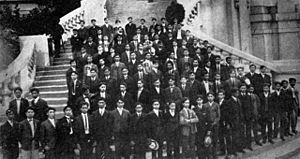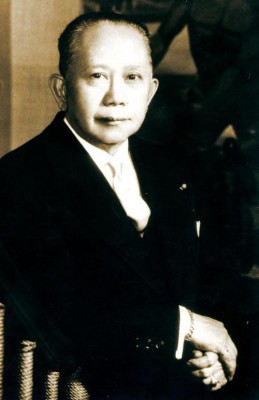Pensionado Act facts for kids
Quick facts for kids Pensionado Act |
|
|---|---|
| Philippine Commission | |
| Philippine Commission's Act 854 | |
| Enacted by | Insular Government of the Philippine Islands |
| Date passed | 26 August 1903 |
| Introduced by | Bernard Moses |
| Summary | |
| Provide for select Filipinos to receive education in the United States | |
| Status: Expired | |
The Pensionado Act was a special law passed on August 26, 1903. It created a scholarship program for young Filipinos to study in the United States. This program helped prepare the Philippines for self-governance. It also aimed to show a good image of Filipinos to Americans. Students who received this scholarship were called pensionados.
About 500 students, starting with 100, got to study in the United States through this program. Many of them became important leaders in the Philippines. Their success inspired over 14,000 other Filipinos to seek education in the United States. Many of these students stayed in the U.S. The Pensionado Act program ended in 1943. It was the largest American scholarship program until the Fulbright Program started in 1948.
During World War II, Japan started a similar program when they occupied the Philippines. After the war, and after the Philippines became independent, Filipino students continued to study in the United States with government help.
Contents
Why Was the Pensionado Act Created?
Education in the Philippines Before 1903
Before 1863, during the Spanish rule in the Philippines, most Filipinos could not get a good education. Only religious schools were common. After the Spanish–American War in 1898, the United States took over the Philippines. This happened because of the Treaty of Paris. Filipinos then became U.S. nationals.
However, many Filipinos wanted independence. They fought against American rule in a conflict that was not successful. Some wealthy Filipino families started sending their children to the United States for school. This was a trend among rich Asian families. For example, Chinese students went to the U.S. starting in 1847. Japanese students followed in 1866.
Improving Education and Relations
The United States opened its first school in the Philippines on Corregidor. The Philippine Commission then passed laws to create public schools. Act Number 74 in 1901 started public schools. Act Number 372 in 1902 created public high schools in each province.
There were not enough teachers, so many American soldiers became teachers. In 1901, over 500 American teachers, known as Thomasites, arrived in the Philippines. They also trained Filipinos to become teachers. Still, there was a shortage of educators.
How the Pensionado Act Was Passed
William Howard Taft, who was the Governor General at the time, wanted to improve relations between Filipinos and Americans. So, on August 26, 1903, the Philippine Commission passed Act 854, also known as the Pensionado Act. The United States Congress also approved it.
Professor Bernard Moses first thought of the idea in 1900. The program aimed to calm Filipino opposition after the Philippine–American War. It also wanted to prepare the Philippines for self-governance. This was done by showing Filipinos American values. The program also aimed to show Americans "the best and brightest Filipino youths." This would create a good impression of the Philippines in the United States.
How the Program Worked

David Prescott Barrows, the director of education in the Philippines, first managed the program. In its first year, 1903, 20,000 people applied. Only about 100 were chosen. These were the first pensionados. They were usually from wealthy and important Filipino families.
Before going to college, these first pensionados attended high school in the U.S. This helped them get used to the language and culture. In some parts of the United States, pensionados were among the first Filipinos to live there. This was true for places like Chicago, New York City, and San Diego. About a quarter of the first group of pensionados studied in the Chicago area.
Who Became a Pensionado?
In the second year of the program, five Pinay (Filipino women) were chosen. There were 39 students in total that year. This meant there were more male pensionados than female. In 1904, pensionados worked as guides and waiters at the Philippines exhibit at the St. Louis Exposition. They showed a different image of Filipinos compared to the Igorots who were also there.
In 1905, only three Pinay were chosen out of 37 new pensionados. The number of pensionados grew steadily. There were 180 in 1907 and 209 in 1912. Some of the first Filipino nursing students in the U.S. were pensionados.
Seven years after the program began, all of the first 100 pensionados had returned to the Philippines. In 1908, the University of the Philippines opened. After this, the program focused more on graduate studies instead of undergraduate degrees. The program paused between 1915 and 1917. In 1921, the Philippine government supported 111 pensionados. Thirteen of them were working on their doctoral degrees.
The End of the Program
From 1903 to 1938, pensionados traveled to the United States to study. Most of them returned to the Philippines. The program officially ended in 1943.
Pensionados were required to work for the government in the Philippines for at least 18 months after returning. Before going back home, some pensionados started student newspapers. These were among the first media for Filipinos living in the United States.
At first, only wealthy families sent their children. But later, more pensionados came from less wealthy families. Funding for the program was reduced during the Great Depression. For example, in 1930, only 13 pensionados were fully or partly funded by the Philippine government. Six others stayed in the U.S. to finish their education at their own cost. Near the end of World War II, some pensionados were trained in foreign relations. This was in preparation for the Philippines becoming independent in 1946.
Where Did Pensionados Study?
Pensionados attended many colleges and universities, including:
- Columbia University
- Cornell University
- Harvard University
- Indiana University
- Massachusetts Institute of Technology
- Oberlin College
- Stanford University
- Syracuse University
- University of California, Los Angeles
- University of Chicago
- University of Illinois
- University of Michigan
- University of Southern California
- University of Washington
What Was the Impact of the Pensionado Act?
When pensionados returned to the Philippines, some people called them "American boys." They sometimes faced unfair treatment. This was because people thought they were too closely linked to American rule. Some later Filipino immigrants to the U.S. also felt this way. The writer Carlos Bulosan wrote about this social difference. However, some returning pensionados helped develop Filipino nationalism.
Most returning pensionados became educators. Some later became school leaders. For example, Esteba Adaba became the director of education for the Philippines. He later became a senator. Jorge Bocobo became President of the University of the Philippines. Pensionados who studied nursing started nursing schools. Their students later moved around the world to help with nursing shortages. Author Bienvenido Santos also became famous.
Other pensionados took important government roles. These included Secretary of Finance Antonio de las Alas, Senator Camilo Osias, Major General Carlos P. Romulo, and Chief Justice José Abad Santos. When architects started to be registered in the Philippines in 1921, a pensionado was the second one registered. In total, about 500 pensionados received scholarships to study in the United States.
Other Filipino Students in the U.S.
The success of the pensionados encouraged other Filipinos to move to the United States. These included students who paid for their own education. Some were veterans of the United States Navy. By the 1920s, these self-funded students were more numerous than the pensionados.
Getting a good education became a major goal for Filipinos coming to the U.S. By 1920, almost 5,000 Filipino students had attended American schools for college-level education. In 1922 alone, nearly 900 Filipinos were in college in the United States. By 1930, Filipinos were the third largest group of international students in the U.S. Only Chinese and Canadian students were more numerous. Some Chinese students also had government funding through the Boxer Indemnity. By 1938, about 14,000 Filipino students had studied in the United States. Some of them got important jobs when they returned home.
Some of these students paid for their education by working as domestic workers. Others worked as farmworkers, like Philip Vera Cruz. Many of these self-funded students did not return to the Philippines. They settled in the United States. For example, E. Llamas Rosario earned graduate degrees and started the Filipino Pioneer newspaper in Stockton, California. These Filipinos, along with others who came for non-educational reasons, started the second wave of Filipino immigration to the United States. Educated Filipinos who stayed in the U.S. often faced unfair treatment when looking for jobs in their fields. Laws in places like California also prevented non-citizens from getting professional licenses.
Similar Scholarship Programs
Boxer Indemnity Scholarship
In 1909, China had overpaid the United States for damages from the Boxer Rebellion. Because of this, the Boxer Indemnity Scholarship was created. This idea came from Edmund James, who was the Chancellor of the University of Illinois. Later payments from China for the Boxer Rebellion were used for this scholarship. A school called Qinghua Preparatory School was opened. It was run by both China and the U.S. to train students going to America. This scholarship lasted until 1937 and funded about 2,000 Chinese students.
Japanese Scholarship Program
During the Japanese occupation of the Philippines, the Japanese government also sponsored students to study in Japan. Two groups were sent in 1943 and 1944. Before leaving, the students were disciplined to remove any anti-Japanese sentiments. This program sent a total of 51 students to Japan. They were called "Nantoku."
Post-Independence Programs
After the Philippines became an independent nation in 1946, thousands more Filipinos came to the United States for education. They used programs like the Fulbright Program. The Fulbright exchanges have become much larger than the original pensionado program. A smaller program, the Smith–Mundt Act, also helped civic leaders from the Philippines study in the U.S.
New Pensionado Act Ideas
In the early 2000s, lawmakers in the Senate of the Philippines have suggested new bills named after the Pensionado Act. In 2010, Senator Miriam Defensor Santiago proposed the "Pensionado Act of 2010," but it did not pass. In 2017, Senator Sonny Angara proposed the "Pensionado Act of 2017." No action was taken on it. He submitted a similar bill, the "Pensionado Act of 2019," to the current Philippine Senate.


